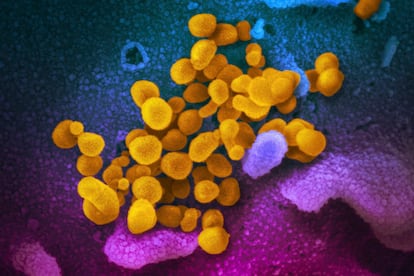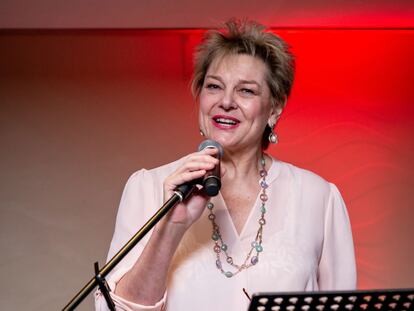First conclusions on omicron: Variant is growing exponentially and it is not clear if it is less severe
Preliminary studies indicate the new coronavirus strain is highly transmissible, even among the vaccinated, but can be controlled with booster shots and other measures

The scientific community has already sketched out a preliminary picture of omicron, the latest variant of the coronavirus, and which was first detected three weeks ago in the south of Africa. The variant, with a never-before-seen number of mutations, is spreading across the planet at an unprecedented speed compared to its predecessors. The European authorities have warned that the growth of omicron is “exponential.” Cases are doubling every two days, according to data from the United Kingdom.
Omicron is able to multiply 70 times faster in human bronchial tissue than the until-now-dominant strain, delta, according to a preliminary study from Hong Kong University, and which was released on Wednesday. The authors, headed by the renowned virologist Michael Chan, infected human cells in a laboratory and observed that omicron is highly successful in the upper respiratory tract, which would explain the explosion of infections, but it is 10 times less efficient than its predecessors in the lungs, which suggests it is less deadly.
Chan has underlined that “it is important to note that the severity of disease in humans is not determined only by virus replication but also by the host immune response to the infection, which may lead to dysregulation of the innate immune system, i.e. cytokine storm [an immune response that can be deadly].” Chan is not optimistic. “By infecting many more people, a very infectious virus may cause more severe disease and death even though the virus itself may be less pathogenic,” he warned in a statement.
A report from the European Center for Disease Prevention and Control (ECDC), published this Wednesday, considers it to be “very likely” that the arrival of omicron will increase hospitalizations and deaths compared to those expected with the delta variant.
Many of the preliminary studies point to omicron being able to trick the first line of human defenses – the antibodies induced by Covid-19 vaccines or a previous infection – and cause new mild infections in people who have only had two doses of a vaccine and in people who have already had the disease. The efficiency of two doses of the Pfizer-BioNTech vaccine at preventing these mild cases falls up to 35% after four months in omicron cases, according to a provisional analysis carried out by the Health Security Agency in the UK. With two injections of the Oxford-AstraZeneca vaccine, the protection falls to 0% in terms of a mild infection.
We’ll be the happiest people in the world to come back to you in two weeks’ time or three weeks’ time and say, this is a much milder disease, but that’s not how this virus has behaved up to nowIrish epidemiologist Michael Ryan
The same study states that this protection rises to 75% for those who were immunized with Pfizer-BioNTech and then given a third dose, and 71% in the case of those who were first given AstraZeneca and then a booster shot of Pfizer. “I suggest that everyone gets their booster shot when it is their turn,” explains one of the coauthors of the study, the British-Spanish epidemiologist Jamie López Bernal. “With the experience that we have with other variants, it’s very likely that the protection against serious complications from Covid is higher than the protection offered against infection, meaning that those who haven’t had their first two doses should get vaccinated as soon as possible.”
A major outbreak in Norway illustrates the ease with which omicron is transmitted, even among vaccinated people. On November 26, 117 employees of the renewable energy firm Scatec held a Christmas dinner in a restaurant in Oslo. One of the attendees had recently returned from South Africa. Practically all of them were vaccinated, but 74% ended up infected with omicron.
With an average age of 38, most of the cases presented coughs, fatigue, runny noses, sore throats and fever, but for now, none have been hospitalized, according to a study by the Norwegian Institute of Public Health (NIPH) released on Thursday. The authors point to the fact that the symptoms appeared in general three days after the party, which is quicker than the delta variant (4.3 days) or the previous strains (five days).
If the omicron strain is evading antibodies, it is finding a second line of defense: T-cells, white cells that, once a mild infection begins, can stop it from developing into serious illness. US vaccinologist Phil Krause, the chair of the World Health Organization’s Vaccines Research Expert Group, stated on Thursday that this barrier of T-cells, both those generated by the vaccines and those that result from previous infections, “remain largely intact against variants including omicron.”
The biggest South African medical insurance company, Discovery, published promising data on Tuesday. Its preliminary analysis of more than 200,000 cases suggests that two doses of the Pfizer vaccine maintain 70% effectiveness – 60% for septuagenarians – for preventing hospitalizations from the omicron variant. This is a fall from the 93% registered against the delta strain, but is still a high level of protection.
However, the effectiveness of two shots of Pfizer for preventing any kind of infection – which would mostly be mild or asymptomatic – barely reaches 33%, compared to 80% previously, according to the insurance firm’s provisional report, which was put together in cooperation with the South African Medical Research Council (SAMRC).
Even in the hypothetical case of omicron being less virulent, if it transmits more efficiently it will end up causing serious cases of illness and deathsIsabel Sola, from Spain’s National Biotechnology Center (CSIC)
Omicron appears to be extremely transmissible. The initial calculations from Discovery also suggest that the risk of reinfection is 40% higher with omicron among people who have already had the delta variant and 73% higher in those who got infected during the first wave in 2020.
The true severity of the Covid caused by omicron is yet to be established, but whatever it is, a flood of new cases could see health systems put under huge pressure. A rise in infected healthcare workers – who would be forced to isolate at home – could leave hospitals without staff. What’s more, as pointed out on social media by British geneticist Jeffrey Barrett, from the Wellcome Sanger Institute: “Testing capacity will almost certainly fail to keep up with #Omicron: even with best efforts we can scale supply linearly, but demand will grow exponentially. This will happen everywhere at (almost) the same time, so global supply chains of reagents, plastics, etc will struggle.”
Testing capacity will almost certainly fail to keep up with #Omicron: even with best efforts we can scale supply linearly, but demand will grow exponentially. This will happen everywhere at (almost) the same time, so global supply chains of reagents, plastics, etc will struggle.
— Jeffrey Barrett (@jcbarret) December 15, 2021
Duncan Robertson, an analytics academic focusing on Covid-19 modeling and analysis at Loughborough and Oxford universities in the UK, summed up the situation in the country with sarcasm via Twitter: “We will not reach one million cases per day. Because we don’t have PCR capacity for one million cases per day.” Dr Adam Kucharski, associate professor at the London School of Hygiene & Tropical Medicine, has also raised the alarm. “Suspect Omicron situational awareness in Europe is about to drop off a cliff. Fast growth in cases and resulting test demand will outstrip capacity, and as Omicron becomes dominant, data on % sequences that are Omicron will no longer be informative about growth.”
Suspect Omicron situational awareness in Europe is about to drop off a cliff. Fast growth in cases and resulting test demand will outstrip capacity, and as Omicron becomes dominant, data on % sequences that are Omicron will no longer be informative about growth. https://t.co/XKeu36k8Ok
— Adam Kucharski (@adamjkucharski) December 15, 2021
Virologist Isabel Sola believes that there is an “exciting question” that is as yet unanswered: whether or not omicron genuinely causes milder disease. The report from the South African insurance firm indicates that adults infected with omicron have a 29% lower risk of needing hospital treatment than in the first wave of the pandemic, but the authors themselves of the document admit that this data could be caused by the simple fact that, in South Africa, a high percentage of the population has already had Covid-19 and has better defenses than in 2020.
Irish epidemiologist Michael Ryan, the executive director of the WHO’s Health Emergencies Programme, insisted on protecting the most-vulnerable people as soon as possible. Speaking on Tuesday, he said: “We’ll be the happiest people in the world to come back to you in two weeks’ time or three weeks’ time and say, this is a much milder disease, everything is fine [...] but that’s not how this virus has behaved up to now, that’s not our experience through the three waves of this pandemic so I think the idea is to act now in the real world while we collect the data to understand exactly what this virus is capable of.”
Isabel Sola, from Spain’s National Biotechnology Center (CSIC), shares these concerns. Applying the principle of caution, with what we know about the partial loss of immunity, we should strengthen re-vaccinations, especially for the most vulnerable. And, at the same time, strengthen the measures that help to contain the spread of the virus: diagnostic testing, masks, social distancing, ventilation, avoiding crowds…” she explains. “Even in the hypothetical case of this being less virulent, if it transmits more efficiently it will end up causing serious cases of illness and deaths,” Sola warns.
American physics professor Albert Allen Bartlett would repeat over and over that the biggest limitation of human beings is their inability to understand exponential growth. This ability, however, is essential to appreciate the scale of the challenge that omicron poses. The concept can be understood with the classic example of folding a piece of paper. If you take a sheet of newsprint, let’s say it is 0.01 centimeters thick for the sake of this example, when you fold it, it will measure 0.02 centimeters. When you fold it again, it will measure 0.04 centimeters. Every time its width will double. If it could be folded 10 times, it would measure more than five centimeters. If it could be folded 15 times, it would be the height of a person. Nineteen times and it would exceed the height of an eight-story building. And with just 23 folds, it would be taller than the Eiffel Tower. That is exponential growth. And that’s the challenge posed by omicron.
Tu suscripción se está usando en otro dispositivo
¿Quieres añadir otro usuario a tu suscripción?
Si continúas leyendo en este dispositivo, no se podrá leer en el otro.
FlechaTu suscripción se está usando en otro dispositivo y solo puedes acceder a EL PAÍS desde un dispositivo a la vez.
Si quieres compartir tu cuenta, cambia tu suscripción a la modalidad Premium, así podrás añadir otro usuario. Cada uno accederá con su propia cuenta de email, lo que os permitirá personalizar vuestra experiencia en EL PAÍS.
¿Tienes una suscripción de empresa? Accede aquí para contratar más cuentas.
En el caso de no saber quién está usando tu cuenta, te recomendamos cambiar tu contraseña aquí.
Si decides continuar compartiendo tu cuenta, este mensaje se mostrará en tu dispositivo y en el de la otra persona que está usando tu cuenta de forma indefinida, afectando a tu experiencia de lectura. Puedes consultar aquí los términos y condiciones de la suscripción digital.
More information
Archived In
Últimas noticias
NASA discovers Titan doesn’t have an ocean, but a ‘slushy ice layer’ that increases possibility of life
Innocence lost in the forest of the child soldiers: ‘Each leader of the armed group had his girls’
‘Fallout’ or how the world’s largest company turned an anti-capitalist apocalyptic Western into a phenomenon
From inflation to defending migrants: Eileen Higgins and Zohran Mamdani inaugurate the new Democratic resistance against Trump
Most viewed
- ‘El Limones’ and the growing union disguise of Mexican organized crime
- Christian Louboutin: ‘Young people don’t want to be like their parents. And if their parents wear sneakers, they’re going to look for something else’
- The low-cost creative revolution: How technology is making art accessible to everyone
- ‘We are dying’: Cuba sinks into a health crisis amid medicine shortages and misdiagnosis
- Liset Menéndez de la Prida, neuroscientist: ‘It’s not normal to constantly seek pleasure; it’s important to be bored, to be calm’











































